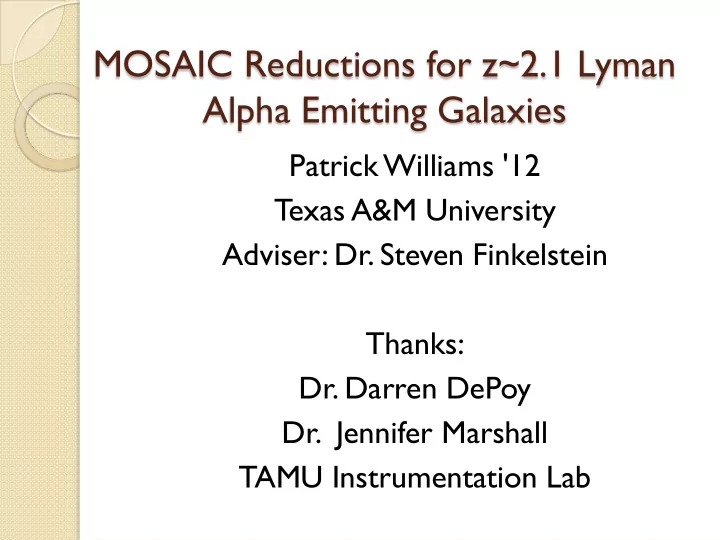

MOSAIC Reductions for z~2.1 Lyman Alpha Emitting Galaxies Patrick Williams '12 T exas A&M University Adviser: Dr. Steven Finkelstein Thanks: Dr. Darren DePoy Dr. Jennifer Marshall TAMU Instrumentation Lab
Project Overview Three data sets from KPNO and CTIO Narrow-band imaging selection of LAEs at z~2.1 Evolution of the luminosity function Investigate age, stellar mass, dust and dark matter halo mass evolution. Credit: S. Finkelstein
Lyman Alpha Emitters (LAEs) Distant galaxies that emit Lyman-alpha radiation Progenitors of local Universe galaxies Most LAEs found in 3.1 < z < 6 (No LF evolution) z~.3 showed fainter M95. Credit: NASA and rarer LAEs
Selection of z~2.1 LAEs cannot be observed from the ground at z < 2 Atmospheric absorption − blueward of 3500 Å z~2.1 is “last stop” Used 3727 Å narrowband − filter for Lyman alpha emission at z~2.1 If no evolution of LF from z= 3.1 – 2.1 ~300 LAEs per pointing − If LF resembles z~0.3 ~10 LAEs per pointing − S. Finkelstein (2008)
Luminosity Function Evolution Gronwall et al. (2007) Deharveng et al. (2008) .2 < z < .35 z~3.1 Lyman Alpha Luminosity: = ⋅ = ⋅ * 42.64 -1 * 42 -1 L 10 erg s L 10 erg s Characteristic Number Density: Φ = Φ = * -2.84 -3 * -3.5 -3 10 Mpc 10 Mpc
Raw Image
Basic Reductions Crosstalk, overscan, trim correction Zeros → Combine − Flats → Normalize → Combine − Objects − Cosmic Ray Rejection Crgrow (residuals) − WCS fitting Inconsistencies with catalogs (mscimage) −
Reductions cont. Clobber bad pixel masks Replace bad pixels with sky values − Mscimage Resampled 8-extension object/bpm frames − into single images with simple WCS Mscimatch Match intensity scales for reconstructed − mosaic image
Post-Mscimage
Stacking Mscstack Combines multiple reconstructed mosaic − images using WCS Excludes chip gaps − Increases effective depth of field (makes − LAE detection easier) Data from 2009 fully stacked (best seeing) If 2007 and 2008 sets give good stack, − possibly combine with 2009
Bad Stack
Good Stack
Post Stacking Fit stellar population models Compare to 3 < z < 6 samples − Study how age, dust content, stellar masses − evolve with redshift Follow up NIR spectroscopy Measure metallicity via N2, O3N2, or R23 − indices Study mass-metallicity relation evolution − with redshift
Thank you! Questions?
Recommend
More recommend